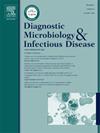Bartonella henselae and Aspergillus flavus coinfection in an immunocompromised patient
IF 2.1
4区 医学
Q3 INFECTIOUS DISEASES
Diagnostic microbiology and infectious disease
Pub Date : 2025-02-10
DOI:10.1016/j.diagmicrobio.2025.116708
引用次数: 0
Abstract
Objective: This clinical study reports a case of atypical cat scratch disease in a patient undergoing immunosuppressive treatment, who contracted COVID-19 during the treatment period. Despite pharmacological and surgical interventions, Bartonella henselae was not completely cleared, leading to the recurrence of symptoms. The study highlights the challenges of management and the need for thorough immune assessment and precise diagnosis.
Methods: A case report provides a detailed description of the treatment process for a young female patient with cat scratch disease (CSD), who had been treated with immunosuppressive agents (adalimumab and baricitinib) for ankylosing spondylitis and developed a concurrent COVID-19 infection during the treatment of CSD.The diagnosis was confirmed through macrogenomic second-generation sequencing. Pharmacological and surgical interventions were administered, and clinical outcomes were monitored.
Results: When a patient is infected with Bartonella henselae and remains in a prolonged immunocompromised state, pharmacological or surgical treatment may still fail to completely clear the pathogen, leading to the recurrence of symptoms.
Conclusion: This case emphasizes the recurrence of symptoms in a patient undergoing long-term immunosuppressive treatment who contracted COVID-19 during Bartonella henselae infection. It suggests a potential interaction between immunosuppression and infection. It highlights the importance of immune assessment, accurate diagnosis, and vigilant management. Appropriate therapeutic strategies should be considered for patients with prolonged illness and impaired self-healing capability. Further research is warranted to clarify the mechanisms behind these interactions and to optimize management strategies for similar cases.
求助全文
约1分钟内获得全文
求助全文
来源期刊
CiteScore
5.30
自引率
3.40%
发文量
149
审稿时长
56 days
期刊介绍:
Diagnostic Microbiology and Infectious Disease keeps you informed of the latest developments in clinical microbiology and the diagnosis and treatment of infectious diseases. Packed with rigorously peer-reviewed articles and studies in bacteriology, immunology, immunoserology, infectious diseases, mycology, parasitology, and virology, the journal examines new procedures, unusual cases, controversial issues, and important new literature. Diagnostic Microbiology and Infectious Disease distinguished independent editorial board, consisting of experts from many medical specialties, ensures you extensive and authoritative coverage.

 求助内容:
求助内容: 应助结果提醒方式:
应助结果提醒方式:


